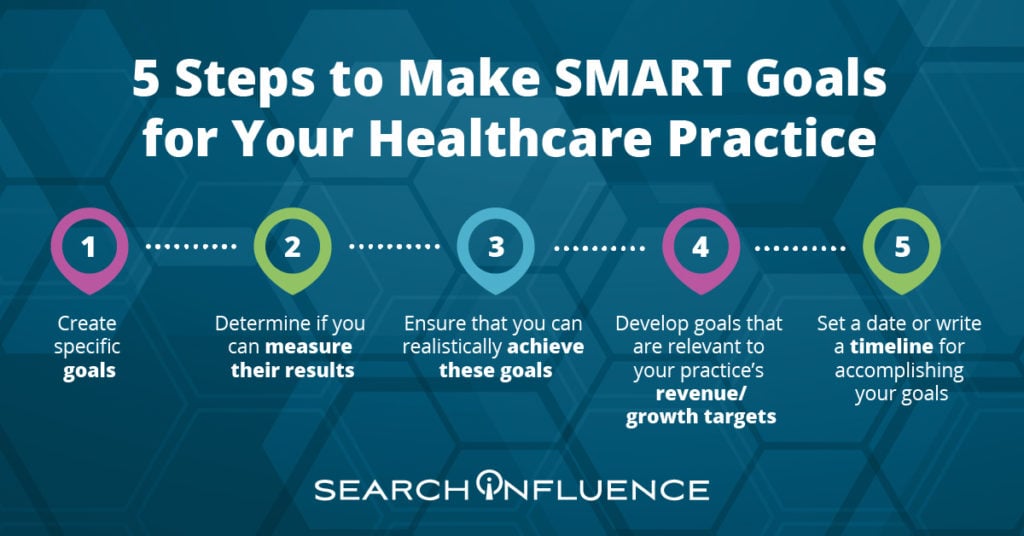6 Steps To Align Your Healthcare Marketing With Business Growth Goals
June 1st, 2021 by
Key Insights
- Set specific, attainable goals that are important to all stakeholders
- Implement measurable tactics to monitor campaign performance
- Track patient booked rate and patient lifetime value to analyze the quality of new business
Introduction
Without clearly identified goals or strategies to measure results, your healthcare marketing efforts may be met with this question, “What are we getting for our marketing investment?”
As a marketer, you should have the ability to point to well-structured, outcomes-focused data to answer this question each time it’s posed. Build ROI-focused marketing goals for your hospital or practice with this guide.
Step 1: Understand Your Needs and Goals
Typically, when stakeholders meet to discuss business growth and development, they discuss marketing needs and opportunities. Key points can include:
- Patient retention
- Filling the number of open beds
- Building patient base to hire more physicians
- Increasing utilization of surgical hours
- Booking available appointment slots
Understanding not only the significance of every need but the opportunity cost of underutilized appointment slots or surgical hours (i.e., missed revenue) is an effective way to triage goals.
When setting goals, communication and accountability are imperative between marketing and operational stakeholders. The team should discuss campaign expectations, what success should look like, and how to measure results.
Some great questions to ask yourself as you’re creating goals are:
- What does success look like?
- What kind of growth do we want to see in 6 months/12 months/2 years?
- What organizational metrics will we track to know if we’re successful? How often can we report on these metrics?
Step 2: Clarify the Product or Services You Want to Promote
Now, let’s connect the “need” to “services” we’ll be promoting. If the need is to increase the number of surgeries and the goal is to increase surgery revenue by 8%, identifying which surgeries have the highest revenue and the greatest opportunities for promotion can drive your campaign strategy.
You can also look at each of the needs in Step 1 by procedure/surgery to help understand the areas for growth.
By doing this, your team will ensure that marketing activity funnels patients to the areas that need and can handle the increased volume instead of funneling more patients to an already overbooked area of the business, where you risk creating unhappy patients.
Step 3: Determine Your Campaign Objectives
Your goals (from Step 1) are the destination of where you want to be, and your campaign objectives are the driving force that get you there. The goals above are big picture organizational impact goals (For example: “Increase appointment time utilization to 90%”), whereas campaign objectives are more specific to the marketing campaigns themselves (For example: “Achieve 50 patient inquiries”).
Objectives keep specific campaigns on track and serve as the foundation of every marketing strategy. At Search Influence, we’re BIG on SMART goal-focused campaign objectives.
- S – Specific
- M – Measurable
- A – Attainable
- R – Relevant
- T – Time-bound
We found this to be one of the most productive ways to work toward an achievable goal and hold our campaigns accountable. The more specific you can be in defining your goal, the better.
For example:
- A campaign objective: “Increase appointments booked.”
- A SMART campaign objective: “By June 1, increase ENT appointments booked by 20 new patients a month by implementing a Google Paid Search campaign.”
To determine if your goal is attainable, compare your current state to where you want to be. Use any historical data or estimates that you can get your hands on.
Using the example above, historical data may show your practice is only seeing an average of 2 new patients per month; a campaign objective that targets 20 new patients within the same timeframe is likely too aggressive for you and your staff. Adjust to something more modest.
Consider how much more effort or how much you’re increasing your investment to drive those additional patients. If you know or can estimate your historical cost per new patient, that is the absolute best way to determine if it’s realistic to drive the number of new patients you want/need with the budget you are adding to your investment. This will help assure your goals are realistic AND profitable for your business.
Step 4: Establish How You’ll Measure ROI
Return on investment (ROI) can be looked at in several ways, with the calculation always being similar:
(Revenue – Marketing Investment) / Marketing Investment
How you apply that calculation may be different. You can look at:
- Overall increase in revenue compared to overall marketing budget
- New patient revenue compared to overall marketing budget
- Procedure-specific revenue compared to procedure-specific marketing budget
- Individual patients acquired by marketing activity compared to the cost to acquire them
Additionally, some may choose to calculate ROI specifically by looking at profit as opposed to revenue. For others, that number may be far too complicated to obtain, so leveraging revenue is most often the more straightforward.
- How can ROI help?
- Justify next year’s marketing budget
- Make your case for an increase in budget
- Help you assess and report on improvements to marketing success for a given period and over time
Step 5: Calculate Your Patient Lifetime Value or Average Revenue Per Patient
You can look at Patient Lifetime Value and Average Revenue as a true average for your facility or you can look at it by department/unit. You can also look at year 1 value of a patient if that’s something that is important to you.
Your patient management system may either provide this information for you or provide you the info you need to calculate this data point.
If you want to come up with an estimate, you can do a simple equation of average cost per visit multiplied by # of visits. If you cannot get actuals, use estimates based on your experience—using estimates is better than having no data at all!
For example, a pediatrician may expect to see a new patient at least 8 times within the first year. That frequency decreases as the patient ages—let’s say you expect 2 well visits and 3 sick visits in year 2. The estimate of sick visits could be based on actual numbers from your patient system, or you can estimate based on your experience. Let’s say the average revenue per visit is $200. This makes the value of the first 2 years is $2,600 (13 visits x $200 per visit). Even if this isn’t exact, it’s helpful to know the value of the patients that marketing is driving in order to use this figure in ROI calculations.
If you really want to use exact numbers, pick a time period, say, the last 2 or 5 years, and pull data and find an average.
One ROI measuring strategy is to center your ROI goals around new patient value. You can use this patient value number as a proxy for revenue in your ROI calculation. This is one way of getting around the need to have access to real revenue data.
Step 6: Consider Your “Close Rate“ or Patient Booked Rate
Now you understand the importance of attainable goals and factoring this into lead acquisition. However, does the number of patient inquiries matter if they aren’t converting via consultations, scheduling surgeries, or attending their follow-up appointments?
Understanding your patient booked rate can build confidence in the attainability of your campaign objective.
To find your patient booked rate, ask yourself:
- If you had 10 inquiries last month, how many of them ended up visiting your facility?
- What factors may have prevented someone who called your office or scheduled an appointment online from qualifying as a good candidate for a procedure?
- Are there internal opportunities to improve how many inquiries turn into in-office visits?
After evaluating the patient booked rate, consider the probability of your team booking 20 new patients a month before finalizing your goal. For example, a practice with a close rate of 80% would need fewer new inquiries to increase their in-office visits than a practice with a 20% close rate. You can also find opportunities internally to increase your booked rate so that you can book more of the inquiries that you want marketing campaigns to deliver.
Understanding these data points will help you have informed, concrete discussions about marketing. They are helpful in budget, performance, and growth conversations.
Search Influence builds your patient pipeline and helps you stay productive. We work with you to set measurable and transparent campaign goals to help you understand how your medical marketing activity impacts your healthcare practice’s success.
Gain professional insight into how to calculate these metrics and set yourself up for success by calling (504) 208-3900 or filling out our form to get the conversation started!




